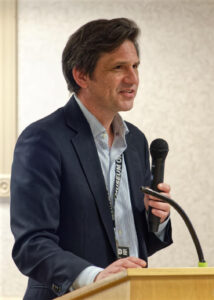Alex Bortolot began is talk telling us a little about his education and work history. He graduated from Harvard University with a BA in the history of art and architecture and holds a PhD in art history from Columbia University. He has an interest in African Art. He then divided his talk into three sections, covering the Hood Museum history, future plans for the museum and upcoming exhibits.

History:
Acquisitions in the museum date back to the 1700. Three of note are a Mastodon molar from Bib Bone Link, Kentucky; scientific instrument, orrery; and a ornate silver vessel. A museum to house all the acquisitions wasn’t established until 1985…the Hood Museum of Art that is adjacent to the Hopkins Center. Prior to this acquisitions could be found in various locations around campus. The goal now is to keep the collections in the newly expanded Hood Museum of Art. Bortolot let us know that items that were part of a Natural History Collection were transferred to the Montshire Museum, that included the Moose that is now on display at the museum.
In 2023, the museum welcomed over 30,000 partons. 12% where school age children, 22% were college students, and 66% were adults.
Future Plans
The Museum wants to be know as a teaching museum. From the Museum’s web page:
Mission: The Hood Museum of Art, Dartmouth, centers art and people in teaching and learning through inclusive and robust academic, cultural, and civic engagements with art and its histories.
Vision: The Hood Museum will advance learning, care, and connections through the reach and relevance of visual art and material culture. As a nexus for the exchange of ideas, the museum will:
- foster environments for mutual learning and teaching;
- embrace a model of care for art and artists; for Dartmouth students, faculty, and staff; for regional residents, teachers, lifelong learners, and visitors; and through its operational and environmental impact; and
- forge meaningful connections across disciplines, peoples, and local and global communities.
The museum is committed to growing the next generation of museum professional. The have developed a three year post graduate fellowship to do this. The fellowship is designed for entry-level candidates who wish to work in the arts and culture sector but do not have the advanced degrees (i.e., master’s or doctoral degrees, or graduate-level coursework) or professional experience and network often required by similar job postings. Instead, following an apprenticeship model, this program emphasizes intensive on-the-job learning, with each member of the cohort spending all three years of the program within one specific discipline.
In addition the offer 20 college seniors internships. Part of this experience is to design an exhibition of interest to them. Hopefully, this creates space for dialogue between students, faculty, staff and the public.
The area surrounding the Hood Museum and currently includes the Hopkins Center and Black Center for Visual Arts is slowly transforming into an arts district. The plan to to move the college to geothermal heat, when this happens the current power-plant will become part of the arts district.
Current and Upcoming Exhibits:
GILDED
FEBRUARY 8 – JUNE 22, 2024
Contemporary Artists Explore Value and Worth
LIVING WITH SCULPTURE
MARCH 23, 2024 – MARCH 22, 2025
Power and Presence in Europe, 1400–1750
Organized thematically, this exhibition focuses on small-scale sculptures found in everyday spaces.
Coming in 2025
CARA ROMERO
JANUARY 18 – AUGUST 10, 2025
Panûpünüwügai (Living Light)
Cara Romero: Panûpünüwügai (Living Light) explores the narrative artistic practice of Chemehuevi photographer Cara Romero. Spanning the past decade of her work, this exhibition presents a thematic examination of Romero’s complex and layered images, which celebrate the multiplicity, beauty, and resilience of Native American and Indigenous experiences.
2026: THE UNITED STATES AT AT 250
In 2026, this exhibit will explore the 250 years of our nations history.

Recent Comments